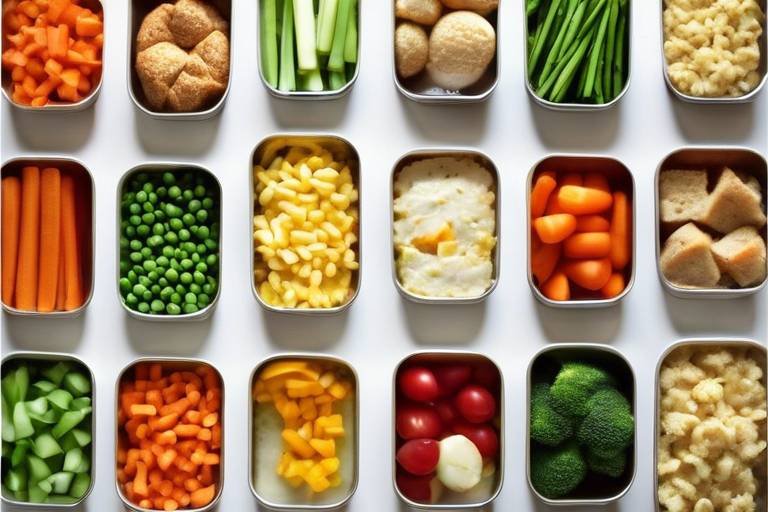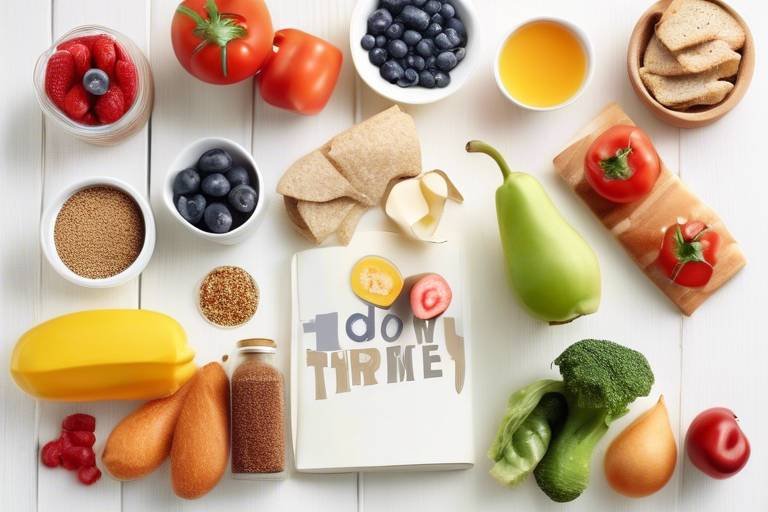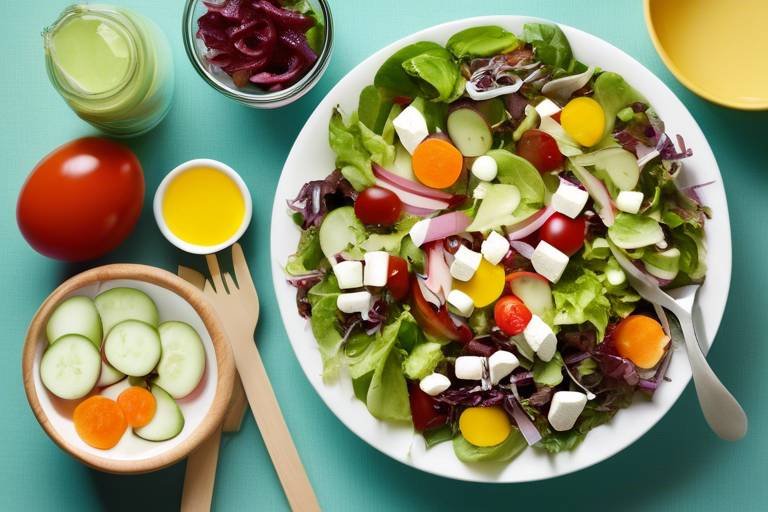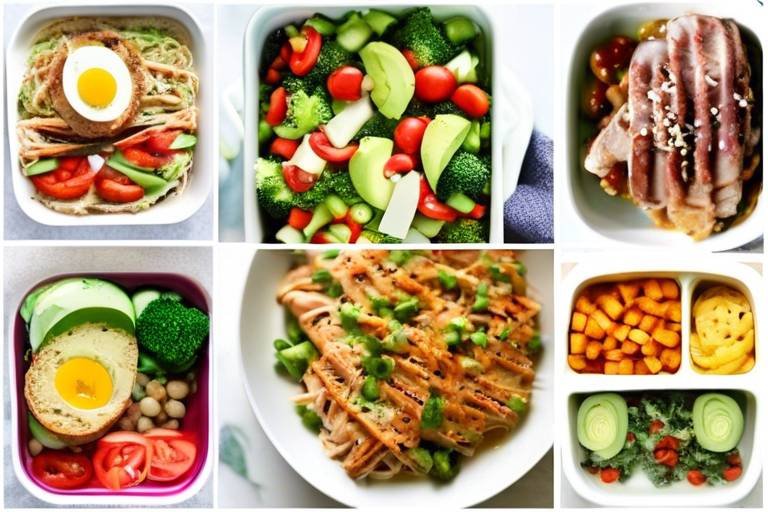Hidden Veggies: Meal Ideas for Picky Eaters
Discovering creative ways to incorporate vegetables into meals for picky eaters can feel like a daunting task. You might be thinking, "How can I get my kids to eat their greens without a fight?" Well, you're not alone! Many parents face the same struggle, and the good news is that there are plenty of delicious and sneaky methods to make veggies appealing and enjoyable for everyone. In this article, we’ll dive into some innovative meal ideas that not only hide those pesky vegetables but also ensure that your family is getting the vital nutrients they need. So, let’s roll up our sleeves and get cooking!
Smoothies are an excellent way to sneak in vegetables without your picky eaters even noticing! Imagine blending a vibrant mix of fruits and veggies together to create a nutritious drink that tastes like a treat. By using ingredients like spinach, kale, or even carrots, you can whip up a smoothie that’s both delicious and packed with vitamins. Try this simple recipe:
1 cup of spinach 1 banana 1 cup of frozen berries 1 cup of almond milk
Blend all these ingredients together until smooth, and voilà! You have a delightful smoothie that’s perfect for breakfast or a snack. The sweetness of the banana and berries masks the flavor of the spinach, making it a win-win for both you and your little ones.
Transforming ordinary sauces by adding pureed vegetables is another fantastic strategy. Think about how many meals revolve around sauces—pasta, pizza, and even tacos! By incorporating veggies into these beloved dishes, you can significantly boost their nutritional value without sacrificing flavor. For instance, a homemade marinara sauce is an excellent canvas for hiding vegetables.
Here’s a simple recipe for marinara sauce that includes hidden carrots and zucchini:
Ingredients: - 1 can of crushed tomatoes - 1 carrot, finely grated - 1 zucchini, finely grated - 1 onion, chopped - 2 cloves of garlic, minced - Olive oil, salt, and pepper to taste
Cook the onion and garlic in olive oil until soft, then add the grated carrot and zucchini. Stir in the crushed tomatoes and let it simmer. This sauce not only tastes delicious but also provides a nutritious base for pasta dishes that kids will devour without realizing they’re eating their veggies!
What about a creamy cheese dip? It can work wonders in masking the taste of vegetables! Consider creating a cheesy dip with hidden spinach or cauliflower. Pair it with chips or fresh veggies, and you’ve got a snack that’s both fun and healthy.
Baking is another golden opportunity to hide vegetables! Muffins and brownies can easily incorporate ingredients like zucchini or sweet potatoes. The best part? They remain deliciously sweet and moist, making them a hit with kids.
These moist and flavorful muffins are an excellent breakfast option. With shredded zucchini mixed into the batter, they add moisture and nutrients while remaining virtually undetectable. Your kids will be asking for seconds before they even realize they’re eating their veggies!
Who doesn’t love brownies? Indulging in delicious brownies made with sweet potatoes provides a healthy twist on a classic dessert. The natural sweetness of the sweet potatoes makes these brownies irresistible, while you sneak in some extra vitamins. It’s like giving dessert a nutritious makeover!
Making veggies visually appealing can entice picky eaters to give them a try. Think of it like this: if you present a plate of food that looks exciting and fun, kids are more likely to dig in. Use cookie cutters to create fun shapes or arrange veggies in a rainbow pattern. The more creative you get, the more likely they are to eat what’s on their plate!
Stir-fries are another versatile option that allows you to incorporate various vegetables while using flavorful sauces that mask their taste. You can whip up a colorful vegetable medley that’s not only nutritious but also visually appealing.
Mix a variety of vegetables—like bell peppers, broccoli, and snap peas—tossed in a savory sauce. The vibrant colors and delightful flavors will have your picky eaters asking for more!
Explore a sweet and sour stir-fry recipe that combines veggies with a tangy sauce. This delightful dish is sure to be a hit, making it an excellent option for even the fussiest eaters.
Soups are a fantastic way to hide vegetables, especially when they’re pureed. Creamy soups can be rich in flavor while incorporating hidden veggies, providing a comforting meal that fills the belly.
This creamy butternut squash soup is not only delicious but also effectively hides the vegetable's nutrients. It’s a perfect starter for picky eaters, and they won’t even know they’re consuming something healthy!
A hearty chowder can be made with pureed veggies, creating a comforting dish that’s filling and nutritious. It’s like a warm hug in a bowl, sneaking in all those essential nutrients without the kids realizing it.
- How can I get my kids to try new vegetables? Present vegetables in fun shapes or pair them with a favorite dip to make them more appealing.
- Are there specific vegetables that are easier to hide? Yes! Spinach, zucchini, and carrots are great options to incorporate into meals.
- What are some good ways to introduce veggies in snacks? Try making veggie chips, smoothies, or cheese dips with hidden vegetables for a tasty snack!

Creative Smoothies
Smoothies are like a secret weapon in the kitchen, especially when it comes to getting picky eaters to consume their daily dose of vegetables. Imagine a delicious, fruity drink that not only tastes amazing but also packs a nutritional punch. The beauty of smoothies lies in their versatility; you can blend almost anything! By combining fruits and veggies, you can create a drink that is both visually appealing and irresistibly tasty. So, how do you make the perfect smoothie that even the pickiest palate will adore?
First, let’s talk about the base. Start with a combination of fruits that your kids already love. Bananas, strawberries, and mangoes are fantastic choices. These fruits are naturally sweet and can easily mask the taste of any vegetables you decide to add. For the veggie component, consider using spinach, kale, or even carrots. These options are mild in flavor and can be easily hidden among the stronger fruit flavors.
Here's a quick smoothie recipe that’s sure to please:
| Ingredients | Amount |
|---|---|
| Banana | 1 medium |
| Frozen Strawberries | 1 cup |
| Spinach | 1 cup |
| Greek Yogurt | ½ cup |
| Milk or Almond Milk | 1 cup |
Blend all these ingredients together until smooth, and voilà! You’ve got a creamy, delicious smoothie that’s packed with nutrients. The spinach is virtually undetectable, and the banana and strawberries provide a delightful sweetness that kids can’t resist. You can even experiment with other ingredients like avocado for creaminess or chia seeds for added fiber. The key is to make it fun and colorful; add a sprinkle of granola on top or a few slices of fruit for garnish, and watch as your little ones dive right in!
Another fantastic idea is to create a smoothie bar at home. Set out a variety of fruits and veggies, along with different types of milk and yogurt. Let your kids mix and match their own ingredients. This not only makes them feel involved but also encourages them to try new flavors. Who knows? They might surprise you with their creativity!
So, the next time you’re struggling to get your picky eaters to eat their veggies, whip up a smoothie! With the right combinations, you can transform what they think of as “yucky greens” into a delightful drink that they’ll ask for again and again. Plus, it’s an excellent way to sneak in those essential vitamins and minerals without any fuss!
Q: Can I use frozen vegetables in smoothies?
A: Absolutely! Frozen vegetables like spinach or cauliflower can be a great addition. They blend well and can even make your smoothie colder and creamier.
Q: What if my child doesn’t like the taste of vegetables?
A: Start with milder vegetables and pair them with sweeter fruits. The key is to balance the flavors so the veggies are masked by the sweetness of the fruits.
Q: How can I make smoothies more filling?
A: Adding a source of protein like Greek yogurt or nut butter can make smoothies more satisfying. You can also incorporate oats or chia seeds for added fiber.

Veggie-Infused Sauces
When it comes to making vegetables more appealing to picky eaters, sauces can be a game changer. By infusing your favorite sauces with pureed vegetables, you can create delicious, flavorful dishes that are packed with nutrition without the fuss. Imagine serving a bowl of pasta or a cheesy pizza that not only tastes amazing but also sneaks in some extra vitamins and minerals. It’s like giving your meals a secret superhero boost!
One of the best things about veggie-infused sauces is their versatility. You can use them in a variety of dishes, from classic spaghetti to hearty casseroles. The trick is to choose vegetables that blend well with the flavors of your sauce. For example, carrots and zucchini can easily be blended into marinara sauce without altering its taste. This means that even the pickiest of eaters won’t realize they’re consuming healthy veggies!
Let’s dive into a simple recipe for homemade marinara sauce that incorporates carrots and zucchini. This sauce is not only easy to make but also incredibly delicious. Here’s what you’ll need:
| Ingredients | Quantity |
|---|---|
| Olive oil | 2 tablespoons |
| Garlic (minced) | 2 cloves |
| Canned crushed tomatoes | 28 ounces |
| Carrots (peeled and chopped) | 1 medium |
| Zucchini (chopped) | 1 medium |
| Italian seasoning | 1 teaspoon |
| Salt and pepper | to taste |
To make this sauce, start by heating the olive oil in a saucepan over medium heat. Add the minced garlic and sauté until fragrant, about 1 minute. Then, toss in the chopped carrots and zucchini, cooking them until they soften (around 5-7 minutes). Next, pour in the crushed tomatoes, Italian seasoning, and season with salt and pepper. Let the sauce simmer for about 20 minutes, allowing the flavors to meld together. Finally, blend the sauce until smooth for a creamy texture that hides those veggies perfectly!
If you’re looking for a fun way to get kids to eat their veggies, try making a cheesy veggie dip. This creamy dip is perfect for parties or as an after-school snack. You can easily hide spinach or cauliflower in this delicious concoction. Here’s a quick recipe:
| Ingredients | Quantity |
|---|---|
| Cream cheese | 8 ounces |
| Shredded cheddar cheese | 1 cup |
| Spinach (cooked and chopped) | 1 cup |
| Garlic powder | 1 teaspoon |
| Salt and pepper | to taste |
To prepare the dip, simply combine all the ingredients in a mixing bowl and blend until smooth. Serve it warm with tortilla chips or fresh veggie sticks for a snack that’s both fun and nutritious. Kids will be so busy enjoying the cheesy goodness that they won’t even notice the hidden spinach!
In conclusion, veggie-infused sauces are an excellent way to make meals more nutritious and appealing to picky eaters. By incorporating pureed vegetables into sauces and dips, you can create delicious dishes that are not only satisfying but also packed with essential nutrients. So, the next time you’re in the kitchen, consider how you can sneak in those veggies and watch your family enjoy their meals with a smile!
Q: Can I use frozen vegetables in my sauces?
A: Absolutely! Frozen vegetables can be a convenient option and are often just as nutritious as fresh ones. Just make sure to thaw and drain them before blending.
Q: Will my kids really not taste the vegetables?
A: Many kids are surprisingly oblivious to the taste of hidden veggies, especially when they’re blended into flavorful sauces. The key is to use vegetables that complement the sauce.
Q: How can I store leftover veggie-infused sauces?
A: You can store leftover sauces in an airtight container in the refrigerator for up to a week. They also freeze well, so you can make a big batch and save some for later!

Homemade Marinara Sauce
When it comes to feeding picky eaters, is a game changer. Not only does it serve as a delicious base for pasta, but it also provides an excellent opportunity to sneak in some nutritious vegetables without raising any red flags! Imagine a rich, flavorful sauce that kids adore, yet it’s packed with hidden carrots and zucchini. Sounds too good to be true? Let’s dive into how you can whip up this magical concoction in your kitchen.
To get started, gather the following ingredients:
- 2 tablespoons olive oil
- 1 medium onion, finely chopped
- 2 cloves garlic, minced
- 1 can (28 ounces) crushed tomatoes
- 1 medium carrot, grated
- 1 medium zucchini, grated
- 1 teaspoon dried oregano
- 1 teaspoon sugar (optional, to balance acidity)
- Salt and pepper to taste
- Fresh basil for garnish (optional)
Now, let’s get cooking! Start by heating the olive oil in a large saucepan over medium heat. Add the chopped onion and sauté until it becomes translucent, which usually takes about 5 minutes. Then, throw in the minced garlic and stir for about 30 seconds until it becomes fragrant. This is where the magic begins, as the aroma will start to fill your kitchen!
Next, it’s time to add the crushed tomatoes. Stir them in and bring the mixture to a gentle simmer. This is also when you’ll want to add the grated carrot and zucchini. These veggies will blend seamlessly into the sauce, providing moisture and nutrients without altering the flavor. Trust me; picky eaters won’t even know they’re there!
As the sauce simmers, sprinkle in the dried oregano and sugar, if using. The sugar helps to cut through the acidity of the tomatoes, making your sauce taste even better. Let everything simmer for about 20-30 minutes, stirring occasionally. This allows the flavors to meld beautifully while the veggies break down into a velvety sauce.
Once the sauce is done, taste and season it with salt and pepper to your liking. If you want to take it a step further, you can use an immersion blender to puree the sauce for an ultra-smooth consistency, perfect for those who are really sensitive to chunks. Serve it over your favorite pasta, and watch as your picky eaters devour their meal with glee!
And there you have it—a simple yet delicious homemade marinara sauce that not only tastes fantastic but also packs a nutritious punch. Pair it with some whole grain pasta or zucchini noodles for an even healthier twist. Your family will be asking for seconds, and you can smile knowing they just enjoyed a serving of hidden veggies!
Q: Can I freeze this marinara sauce?
A: Absolutely! This sauce freezes wonderfully. Just let it cool completely, then transfer it to an airtight container or freezer bags. It can last up to 3 months in the freezer. When you're ready to use it, simply thaw it in the refrigerator overnight and reheat on the stove.
Q: What other vegetables can I add?
A: The beauty of marinara sauce is its versatility! You can experiment with adding pureed bell peppers, spinach, or even mushrooms. Just remember to keep the flavors balanced so that picky eaters won’t notice anything unusual!
Q: Is this recipe suitable for a vegan diet?
A: Yes, this homemade marinara sauce is completely vegan! It’s made with plant-based ingredients, making it a perfect option for anyone following a vegan lifestyle.

Cheesy Veggie Dip
If you’re on a quest to make vegetables more appealing to picky eaters, then look no further than this . Imagine a rich, creamy dip that not only delights the taste buds but also sneaks in some nutritious veggies without anyone batting an eye. Sounds like a dream, right? This dip is the ultimate disguise for vegetables like spinach or cauliflower, transforming them into a cheesy, savory experience that pairs perfectly with chips, crackers, or fresh veggies.
To whip up this delightful dip, you’ll need a few simple ingredients. Here’s what you’ll need:
- 1 cup of shredded cheese (cheddar works great!)
- 1 cup of cream cheese
- 1 cup of pureed spinach or cauliflower
- 1/2 cup of sour cream
- 1 teaspoon of garlic powder
- Salt and pepper to taste
Start by preheating your oven to 350°F (175°C). In a mixing bowl, combine the cream cheese, sour cream, and pureed vegetables. Blend them until smooth and creamy, ensuring that the veggies are well incorporated. Next, stir in the shredded cheese, garlic powder, and a pinch of salt and pepper. Once everything is well-mixed, transfer the mixture to an oven-safe dish and bake for about 20 minutes or until it’s bubbly and golden on top.
What’s fantastic about this dip is its versatility. You can serve it warm or cold, and it pairs well with a variety of dippers, such as:
- Fresh vegetable sticks (carrots, celery, bell peppers)
- Chips or tortilla chips
- Crackers
So, what’s the secret behind making picky eaters enjoy this dip? It’s all about the cheesy goodness that masks the veggie flavors! The creaminess and the cheesy flavor create a comforting experience that makes it hard to resist. Plus, serving it in a fun bowl or alongside colorful dippers can make it even more enticing. Just imagine the smiles on their faces when they dip a chip into this cheesy delight, completely unaware of the hidden veggies packed inside!
Whether you’re hosting a party or just looking for a snack, this is a game-changer. It’s not just a dip; it’s a sneaky way to boost your family's vegetable intake while satisfying their cravings. So, go ahead, give it a try, and watch as even the fussiest eaters dive in for more!
Q: Can I use frozen spinach or cauliflower for this recipe?
A: Absolutely! Just be sure to thaw and drain any excess moisture before pureeing.
Q: What can I substitute for cream cheese if I want a lighter version?
A: You can use Greek yogurt or cottage cheese as a substitute for a lighter option.
Q: How long can I store the leftover dip?
A: The dip can be stored in an airtight container in the refrigerator for up to 3 days.
Q: Can I add other veggies to the dip?
A: Yes! Feel free to experiment with other pureed vegetables like carrots or bell peppers for added flavor and nutrition.

Veggie-Packed Baked Goods
When it comes to getting picky eaters to enjoy their vegetables, baked goods can be a game changer! Imagine biting into a warm, fluffy muffin or a decadent brownie, only to discover that it’s packed with hidden veggies. Sounds too good to be true, right? But it’s not! Incorporating vegetables into baked treats not only adds nutrition but also enhances the flavor and moisture, making them irresistible even to the fussiest of eaters. Let’s dive into some delightful recipes that will transform your baking routine and sneak in those essential nutrients.
One of the most popular choices for veggie-packed baked goods is zucchini muffins. These muffins are incredibly moist and flavorful, thanks to the shredded zucchini that blends seamlessly into the batter. You can easily whip up a batch using basic ingredients like flour, sugar, eggs, and of course, the star ingredient—zucchini! Here’s a quick overview of what you’ll need:
| Ingredient | Quantity |
|---|---|
| Zucchini (shredded) | 1 cup |
| All-purpose flour | 2 cups |
| Sugar | 3/4 cup |
| Baking powder | 2 tsp |
| Eggs | 2 |
| Vegetable oil | 1/2 cup |
| Vanilla extract | 1 tsp |
Mix all the ingredients together, pour them into muffin tins, and bake at 350°F (175°C) for about 20-25 minutes. The result? Moist, delicious muffins that are so good, your kids won’t even notice the zucchini! You can even add in some chocolate chips or nuts for an extra treat.
Next on the list are sweet potato brownies. Yes, you read that right! Brownies made with sweet potatoes not only taste fantastic but also provide a healthy twist on a classic dessert. The natural sweetness of the sweet potatoes allows you to cut down on added sugars, making these brownies a guilt-free indulgence. Here’s how you can make them:
- Ingredients: Sweet potatoes, cocoa powder, flour, eggs, and a few other pantry staples.
- Instructions: Bake the sweet potatoes until soft, mash them, and mix with the other ingredients. Pour into a baking dish and bake until fudgy perfection is achieved.
These brownies are rich, chocolatey, and packed with vitamins, making them a perfect dessert for kids and adults alike. You can even top them with a light dusting of powdered sugar or a scoop of ice cream for an extra special treat.
Incorporating vegetables into baked goods doesn’t just stop at muffins and brownies. You can also experiment with carrot cakes, pumpkin bread, and even beetroot cupcakes. The possibilities are endless! The key is to remember that the veggies you choose should complement the flavors of your baked goods. For instance, carrots and cinnamon make a perfect match, while pumpkin pairs beautifully with spices like nutmeg and ginger.
So, the next time you’re in the kitchen, consider whipping up some veggie-packed baked goods. They’re not only a sneaky way to get your kids to eat their vegetables, but they also make for a delicious and satisfying treat that everyone will love. Remember, it’s all about creativity in the kitchen and making healthy eating fun!
Q: Can I use frozen vegetables in baked goods?
A: Yes, you can! Just make sure to thaw and drain any excess moisture before adding them to your batter.
Q: Will my kids really not taste the vegetables?
A: Most likely! When blended well with other ingredients, the flavors of the vegetables often get masked by the sweetness of the baked goods.
Q: Can I substitute vegetables in any recipe?
A: While many recipes can be adapted, it’s best to start with recipes specifically designed to incorporate vegetables for the best results.

Zucchini Muffins
If you’re looking for a delicious breakfast option that even the pickiest of eaters will love, look no further than these moist and flavorful zucchini muffins. At first glance, they may seem like your typical muffin, but hidden within their soft, fluffy texture is a secret ingredient: shredded zucchini! This versatile vegetable not only adds moisture but also packs in essential nutrients without altering the taste. Imagine biting into a warm muffin and being pleasantly surprised by its delightful flavor while knowing you’ve snuck in some healthy goodness. It's like a ninja move in the kitchen!
To make these muffins, you’ll need a few simple ingredients that you probably already have in your pantry. Here’s a quick breakdown:
| Ingredient | Amount |
|---|---|
| All-purpose flour | 1 ½ cups |
| Granulated sugar | ¾ cup |
| Baking powder | 1 teaspoon |
| Baking soda | ½ teaspoon |
| Salt | ¼ teaspoon |
| Eggs | 2 large |
| Vegetable oil | ⅓ cup |
| Shredded zucchini | 1 cup |
| Vanilla extract | 1 teaspoon |
Now, if you’re wondering how to put all of this together, it’s as easy as pie—or should I say, muffins? Start by preheating your oven to 350°F (175°C) and lining a muffin tin with paper liners. In a large bowl, mix your dry ingredients: flour, sugar, baking powder, baking soda, and salt. In another bowl, whisk together the eggs, vegetable oil, shredded zucchini, and vanilla extract. Combine the wet and dry ingredients, stirring just until everything is moistened. Overmixing can lead to tough muffins, and nobody wants that!
Once your batter is ready, scoop it into the muffin tin, filling each cup about two-thirds full. Bake for about 20-25 minutes, or until a toothpick inserted into the center comes out clean. The aroma wafting through your kitchen will be absolutely irresistible. Let them cool for a few minutes before enjoying these little bundles of joy!
What’s even better? You can customize these zucchini muffins to suit your family’s taste. Want to add some chocolate chips for a sweet treat? Go for it! Prefer nuts for a bit of crunch? Toss them in! You can even throw in some cinnamon for an extra flavor boost. The possibilities are endless, and the best part is that the zucchini remains virtually undetectable. It’s like a secret ingredient that works wonders behind the scenes.
In summary, these zucchini muffins are not just a clever way to sneak in some vegetables; they’re also a tasty and satisfying option for breakfast or a snack. So, the next time you find yourself battling a picky eater, whip up a batch of these muffins and watch them disappear in no time. It's a win-win situation—deliciousness for them and nutrition for you!
- Can I use frozen zucchini for these muffins?
Yes, you can! Just make sure to thaw and drain any excess moisture before adding it to the batter. - How do I store leftover muffins?
Keep them in an airtight container at room temperature for up to 3 days, or refrigerate for longer freshness. - Can I make these muffins gluten-free?
Absolutely! Substitute the all-purpose flour with a gluten-free flour blend.

Sweet Potato Brownies
Indulging in desserts is a universal pleasure, but what if you could enjoy a decadent treat while sneaking in some nutritious ingredients? Enter ! These brownies are not just delicious; they are also a clever way to incorporate vegetables into your family's diet, especially for those picky eaters who turn their noses up at anything green. With a rich, fudgy texture and a hint of sweetness, these brownies will have your kids asking for seconds without even realizing they're packed with healthy goodness.
So, how do you make these delightful treats? The secret lies in the sweet potato. When baked and pureed, sweet potatoes lend a natural sweetness and moisture to the brownies, ensuring they remain soft and chewy. Plus, they are rich in vitamins A and C, fiber, and antioxidants. You might be wondering how to get started, so here's a simple recipe to whip up a batch:
Ingredients: - 1 cup mashed cooked sweet potatoes (about 1 large sweet potato) - 1/2 cup almond butter or peanut butter - 1/2 cup cocoa powder - 1/2 cup honey or maple syrup - 2 large eggs - 1 teaspoon vanilla extract - 1/2 teaspoon baking powder - A pinch of salt
Now, let’s dive into the steps:
- Preheat your oven to 350°F (175°C) and grease an 8x8 inch baking dish.
- In a mixing bowl, combine the mashed sweet potatoes, almond butter, cocoa powder, honey, eggs, vanilla extract, baking powder, and salt.
- Stir until all ingredients are well combined and the mixture is smooth.
- Pour the batter into the prepared baking dish and spread it evenly.
- Bake for about 25-30 minutes, or until a toothpick inserted in the center comes out clean.
- Allow the brownies to cool before cutting them into squares.
And there you have it! A simple, guilt-free dessert that tastes like a treat but is loaded with nutritional benefits. You can even enhance the flavor by adding chocolate chips or nuts for an extra crunch. These brownies are perfect for school lunches, after-school snacks, or even a dessert after dinner. The best part? Your kids will be none the wiser about the hidden veggies!
Now, let’s address some common questions that might pop up when making these delicious Sweet Potato Brownies:
- Can I use canned sweet potatoes? Yes, canned sweet potatoes can be a convenient alternative. Just make sure to drain them well before mashing.
- How do I store leftovers? Store any leftover brownies in an airtight container at room temperature for up to 3 days, or refrigerate for up to a week.
- Can I freeze these brownies? Absolutely! These brownies freeze well. Just wrap them individually in plastic wrap and place them in a freezer-safe bag for up to 3 months.
In conclusion, Sweet Potato Brownies are not just a delicious dessert; they are a fantastic way to sneak some nutrition into your child's diet without them even knowing it. So, go ahead and indulge in this sweet, healthy treat that everyone will love!

Fun Shapes and Presentations
When it comes to getting picky eaters to enjoy their veggies, presentation is everything! Imagine serving a plate of broccoli that looks like a tree or carrots cut into fun shapes. Suddenly, those veggies become more than just food; they transform into a playful experience that kids (and even adults) can't resist. Creativity in presentation can make a world of difference in how vegetables are perceived. Why not turn mealtime into a fun art project?
One effective strategy is to use cookie cutters to create interesting shapes from vegetables. You can make stars, hearts, or even animal shapes out of cucumbers, bell peppers, and more. This simple act can spark curiosity and excitement around eating. For instance, if you cut a cucumber into star shapes and pair it with a delicious dip, it becomes a party on a plate! Not only do the shapes make the veggies more appealing, but they also encourage kids to try something new.
Another great idea is to create colorful veggie skewers. Just take a skewer and alternate between various vegetables like cherry tomatoes, bell pepper chunks, and zucchini slices. The vibrant colors and fun shapes will draw attention, and the act of eating from a stick can make it feel less like a chore and more like a fun activity. You could even let your kids help with this—allowing them to choose their favorite veggies for the skewers can increase their willingness to eat them.
Don’t forget about the power of color! A rainbow plate filled with different colored vegetables can be visually stunning. Consider a mix of red bell peppers, yellow corn, green cucumbers, and purple cabbage. Not only does it look appealing, but it also provides a variety of nutrients. You can even create a themed meal, like a "garden party," where you serve veggies in a way that resembles a garden, complete with edible flowers and herb garnishes.
Lastly, consider the use of dips and sauces. Kids often love to dip their food, so serving veggies with a tasty dip can make them much more enticing. Whether it's a creamy ranch, hummus, or a cheesy sauce, the right dip can turn any vegetable into a delicious snack. Pairing a colorful assortment of veggies with a fun dip can create an interactive eating experience that encourages kids to dig in.
- How can I make vegetables more appealing to my kids?
Try using fun shapes, colorful presentations, and dips to make them more exciting! - What are some good dips for veggies?
Some popular options include ranch dressing, hummus, guacamole, or a cheesy dip. - Can I involve my kids in the preparation?
Absolutely! Letting them help with cutting shapes or assembling skewers can increase their interest in eating the veggies.

Flavorful Stir-Fries
Stir-fries are a culinary wonder! They’re not only quick to prepare but also incredibly versatile, making them a go-to choice for busy families. Imagine a colorful plate filled with vibrant vegetables sizzling away in a hot pan, releasing tantalizing aromas that fill your kitchen. But here’s the kicker: you can easily incorporate a variety of vegetables into these dishes without your picky eaters even noticing! How? By using flavorful sauces and clever cooking techniques that mask the taste of those nutritious veggies.
One of the best things about stir-fries is the ability to customize them based on your family's preferences. You can mix and match different vegetables, proteins, and sauces to create a dish that’s not only healthy but also delicious. For instance, consider using a combination of bell peppers, broccoli, and snap peas, which not only add a pop of color but also pack a nutritional punch. The secret lies in the sauce. A well-balanced sauce can elevate the dish, making even the most reluctant veggie eaters excited to dig in!
Here’s a simple approach to crafting a flavorful stir-fry that will impress even the pickiest of eaters. Start by selecting your favorite protein, such as chicken, beef, or tofu. Then, choose a variety of vegetables. Here’s a quick list of some great options:
- Bell Peppers
- Broccoli
- Carrots
- Snap Peas
- Zucchini
Once you have your ingredients ready, it’s time to whip up a sauce. A basic stir-fry sauce can be made from soy sauce, garlic, ginger, and a hint of sesame oil. This combination not only adds depth of flavor but also helps to mask the taste of the vegetables. Don’t forget to add a sprinkle of sesame seeds for an extra crunch!
To cook, heat a tablespoon of oil in a large skillet or wok over medium-high heat. Start by sautéing your protein until it’s cooked through, then add the vegetables. Stir-fry them for just a few minutes until they’re tender-crisp, ensuring they retain their vibrant colors and nutrients. Finally, pour in your sauce, tossing everything together until well-coated. Serve it over a bed of rice or noodles for a complete meal that’s sure to please!
For a fun twist, consider making a Sweet and Sour Veggies stir-fry. This dish combines the natural sweetness of bell peppers and pineapple with a tangy sauce that’s irresistible. It’s a fantastic way to introduce new flavors while keeping the meal enjoyable. Just think of it as a flavor explosion on a plate!
Incorporating stir-fries into your weekly meal plan is a game-changer. Not only do they allow you to sneak in those hidden veggies, but they also encourage your family to try new ingredients in a fun and engaging way. So, the next time you’re faced with a picky eater, grab a wok, gather those colorful veggies, and let the stir-fry magic happen!
Q: Can I use frozen vegetables for stir-fries?
A: Absolutely! Frozen vegetables are a convenient option and can be just as nutritious as fresh ones. Just be sure to thaw and drain them before cooking to avoid excess moisture.
Q: What are some good sauces for stir-fries?
A: Some popular options include teriyaki sauce, sweet and sour sauce, and hoisin sauce. Feel free to experiment with different flavors to find what your family enjoys most!
Q: How can I make my stir-fry healthier?
A: To boost the health factor, use lean proteins, incorporate plenty of colorful vegetables, and opt for whole grain rice or noodles. You can also reduce the amount of oil and sugar in your sauces.

Colorful Vegetable Medley
Creating a is not only a feast for the eyes but also a delightful way to sneak in a variety of vegetables that even the pickiest eaters will find hard to resist. Imagine a vibrant stir-fry bursting with colors—crisp bell peppers, bright green broccoli, and vivid orange carrots all dancing together in a hot skillet. The key to making this dish appealing is not just in the colors but also in the flavors and textures that come together harmoniously.
To start, choose a selection of vegetables that are not only colorful but also packed with nutrients. Here’s a quick guide to some great options:
| Vegetable | Color | Nutritional Benefit |
|---|---|---|
| Bell Peppers | Red, Yellow, Green | High in Vitamin C and antioxidants |
| Broccoli | Green | Rich in fiber and vitamins K and C |
| Carrots | Orange | Great source of beta-carotene, which converts to Vitamin A |
| Zucchini | Green | Low in calories and high in Vitamin C |
| Red Cabbage | Purple | Contains anthocyanins, which have antioxidant properties |
Once you’ve selected your vegetables, the next step is to chop them into bite-sized pieces. This not only makes them easier to cook but also more appealing to little hands and mouths. When cooking, use a splash of olive oil and a dash of soy sauce or teriyaki sauce to enhance the flavors without overpowering the natural sweetness of the veggies. Stir-frying over high heat allows the vegetables to retain their crunch, making every bite a satisfying experience.
But here’s the magic trick: add a sprinkle of sesame seeds or a handful of cashews just before serving. This not only adds a delightful crunch but also elevates the dish to something special. The combination of colors, textures, and flavors will make your a hit at the dinner table, transforming skeptics into veggie lovers.
Additionally, you can get creative with presentation. Serve the medley in a fun shape or arrange it in a rainbow pattern on the plate. Kids are naturally attracted to bright colors, and this simple trick can make them more inclined to try those veggies. Remember, the goal is to make vegetables fun and exciting. With a little creativity and flair, you’ll see how easy it can be to turn your picky eaters into adventurous foodies!
Q: Can I use frozen vegetables for the medley?
A: Absolutely! Frozen vegetables are often flash-frozen at their peak freshness and can be just as nutritious as fresh ones. Just be sure to sauté them until heated through without overcooking.
Q: How can I make this dish more filling?
A: Consider adding a protein source like chicken, tofu, or shrimp. You could also serve the medley over rice or quinoa for a heartier meal.
Q: What if my kids still refuse to eat vegetables?
A: Keep experimenting with different cooking methods and flavors. Sometimes, roasting vegetables can enhance their sweetness, making them more appealing. Also, involving kids in the cooking process can spark their interest in trying new things.

Sweet and Sour Veggies
If you’re looking for a way to make vegetables more appealing to picky eaters, then might just be your secret weapon! This dish combines the tangy flavors of sweet and sour sauce with a colorful array of vegetables, creating a meal that’s not only delicious but also visually enticing. Imagine a plate filled with vibrant bell peppers, crisp snap peas, and tender carrots, all coated in a glossy, flavorful sauce that kids won’t be able to resist. The beauty of this dish lies in its versatility; you can mix and match your favorite vegetables, and the sweet and sour sauce will do the rest of the work in masking any veggie aversions.
To prepare this delightful dish, start by selecting your vegetables. Here’s a quick list of some great options to consider:
- Bell peppers (red, yellow, green)
- Carrots
- Snap peas or snow peas
- Broccoli florets
- Onions
Once you have your veggies ready, it’s time to whip up the sauce. The sweet and sour sauce typically consists of a few key ingredients: brown sugar, vinegar, ketchup, and soy sauce. The combination creates a perfect balance of sweetness and tanginess that can make even the most reluctant veggie eaters take a bite. Here’s a simple recipe to get you started:
| Ingredient | Amount |
|---|---|
| Brown Sugar | 1/4 cup |
| Vinegar (white or apple cider) | 1/4 cup |
| Ketchup | 1/2 cup |
| Soy Sauce | 2 tablespoons |
Now, here’s how to bring it all together:
- In a small bowl, mix together the brown sugar, vinegar, ketchup, and soy sauce until well combined.
- In a large skillet or wok, heat a bit of oil over medium-high heat. Add your chosen vegetables and stir-fry until they are tender-crisp.
- Pour the sweet and sour sauce over the vegetables and stir to coat everything evenly. Cook for another 2-3 minutes until the sauce thickens slightly.
- Serve hot over rice or noodles for a complete meal that your picky eaters will love!
Not only does this dish taste fantastic, but it also presents a wonderful opportunity for you to sneak in those essential nutrients. By making the vegetables the star of a sweet and sour dish, you’re not just filling bellies; you’re also fueling growing bodies with the vitamins and minerals they need. Plus, the colorful presentation is sure to catch the eye of even the fussiest eaters!
So the next time you’re struggling to get your little ones to eat their veggies, remember that a little creativity can go a long way. Sweet and sour veggies are not just a meal; they’re a gateway to healthier eating habits, one delicious bite at a time.
Q: Can I use frozen vegetables for this recipe?
A: Absolutely! Frozen vegetables are a great time-saver and can be just as nutritious as fresh ones. Just make sure to thaw and drain them before adding to the skillet.
Q: What if my kids don’t like certain vegetables?
A: No problem! Feel free to substitute any vegetables they enjoy. The sweet and sour sauce works well with a variety of veggies, so customize it to your family’s tastes.
Q: Can I make this dish ahead of time?
A: Yes, you can prepare the sauce and chop the vegetables ahead of time. Just stir-fry them fresh when you’re ready to serve for the best texture and flavor.

Deceptive Soups
Soups are like a warm hug on a chilly day, and they can also be a sneaky way to incorporate vegetables into your meals. Imagine serving a creamy, velvety soup that kids can't resist, only to have it packed with hidden veggies! The beauty of soups is that they can be pureed, blended, and transformed into delightful concoctions that mask the taste of those nutritious greens. So, how do you create these deceptive soups? Let’s dive into a couple of recipes that are sure to impress even the pickiest eaters.
This creamy butternut squash soup is a game changer! Not only is it delicious, but it also hides the nutrients of the squash effectively. To make this soup, you’ll need:
- 1 medium butternut squash, peeled and cubed
- 1 onion, chopped
- 2 cloves of garlic, minced
- 4 cups of vegetable broth
- 1 cup of coconut milk (for creaminess)
- Salt and pepper to taste
- A pinch of nutmeg (optional, for flavor)
Start by sautéing the onion and garlic in a pot until they are soft and fragrant. Add the cubed butternut squash and vegetable broth, bringing it to a boil. Let it simmer until the squash is tender, about 20 minutes. Now, here comes the fun part! Use an immersion blender or transfer the soup to a blender and puree until smooth. Stir in the coconut milk, season with salt, pepper, and nutmeg, and voilà! You have a creamy soup that kids will love without even realizing they’re eating vegetables.
Now, let’s talk about a hearty vegetable chowder that’s perfect for cozy nights. This chowder is not only filling but also a fantastic way to sneak in a variety of vegetables. You’ll need:
- 2 cups of mixed vegetables (carrots, peas, corn, etc.)
- 1 potato, diced
- 1 onion, chopped
- 2 cups of vegetable broth
- 1 cup of milk (or a dairy-free alternative)
- Salt and pepper to taste
Begin by sautéing the onion in a large pot until translucent. Add the diced potato and mixed vegetables, followed by the vegetable broth. Allow this to simmer until the potatoes are tender. Once everything is cooked, you can puree a portion of the chowder to give it that creamy texture while leaving some chunks for a delightful bite. Stir in the milk, season, and serve it hot! This chowder is not only comforting but also a fantastic way to fill little bellies with nutrients without them even noticing.
Q: Can I use frozen vegetables in these soups?
A: Absolutely! Frozen vegetables are a great time-saver and can be just as nutritious as fresh ones. Just make sure to adjust cooking times as needed.
Q: How can I make these soups more flavorful?
A: Adding herbs and spices can elevate the flavor. Consider using thyme, rosemary, or even a splash of lemon juice for a fresh twist!
Q: Are these soups suitable for meal prep?
A: Yes! These soups can be made in batches and stored in the fridge or freezer. Just reheat when you’re ready to serve!
With these deceptive soups in your culinary arsenal, you can easily make veggies appealing to even the fussiest of eaters. So, grab those ingredients, get cooking, and watch as your little ones enjoy their meals while sneaking in all those essential nutrients!

Butternut Squash Soup
When it comes to comforting meals, is a true champion. This creamy delight is not only a feast for the taste buds but also a sneaky way to pack in nutrients without your picky eaters even realizing it. Imagine a bowl of velvety soup that warms you up on a chilly day, filled with the subtle sweetness of roasted squash, and a hint of spice that dances on your palate. It’s like a hug in a bowl!
Butternut squash is rich in vitamins A and C, making it a powerhouse for immune support and eye health. The smooth texture of the soup allows you to incorporate other hidden veggies, such as carrots or even a splash of spinach, without altering the delightful flavor. Plus, it’s incredibly easy to prepare! All you need is a few simple ingredients, and you’re on your way to creating a dish that even the pickiest of eaters will ask for seconds.
Here’s a quick rundown of how to whip up this delicious soup:
- Ingredients:
- 1 medium butternut squash, peeled and cubed
- 1 onion, chopped
- 2 carrots, chopped
- 4 cups vegetable broth
- 1 teaspoon garlic powder
- Salt and pepper to taste
- Optional: a dash of nutmeg or cinnamon for warmth
- Preparation Steps:
- In a large pot, sauté the onion and carrots until they are soft.
- Add the cubed butternut squash and vegetable broth, bringing it to a boil.
- Reduce the heat and let it simmer until all the vegetables are tender.
- Use an immersion blender to puree the soup until smooth. If you don’t have one, carefully transfer the mixture to a blender in batches.
- Season with garlic powder, salt, and pepper. Add nutmeg or cinnamon if desired.
- Serve warm, perhaps with a dollop of cream or a sprinkle of croutons for added texture.
This soup is not just a meal; it’s an experience. The creamy texture and rich flavor can transform dinner time into a delightful adventure. You can even involve your kids in the preparation—let them help with stirring or adding ingredients. It’s a great way to make them feel part of the cooking process, which can sometimes encourage them to try new things.
So, the next time you're looking for a way to sneak some veggies into your family's diet, remember this recipe. It’s a deliciously deceptive dish that ensures your family gets their fill of nutrients without the fuss. And who knows? They might just fall in love with the flavors and ask for it regularly!
- Can I freeze butternut squash soup? Yes! This soup freezes beautifully. Just cool it completely before transferring it to an airtight container. It can be stored for up to 3 months.
- What can I serve with butternut squash soup? Pair it with crusty bread, a fresh salad, or even grilled cheese sandwiches for a comforting meal.
- Can I add other vegetables? Absolutely! Feel free to add other veggies like sweet potatoes or even a handful of greens for extra nutrition.

Vegetable Chowder
If you're looking for a way to sneak in those essential nutrients without the kids even noticing, then is your secret weapon. This creamy, hearty dish is like a cozy hug in a bowl, perfect for chilly nights or whenever you need a bit of comfort food. The best part? You can pack it full of veggies that even the pickiest eaters will devour. Imagine a rich, velvety soup that not only warms the soul but also fills little tummies with goodness. Sounds dreamy, right?
To create a delicious vegetable chowder, you can start with a base of potatoes, which provide that creamy texture and heartiness that everyone loves. Then, add in a variety of pureed vegetables like carrots, celery, and even some sneaky spinach. These ingredients will not only boost the nutritional value but also enhance the flavor profile without overpowering the dish. The trick is to blend them until smooth, so they become a hidden treasure in the chowder.
Here’s a simple recipe to get you started:
| Ingredients | Quantity |
|---|---|
| Potatoes (diced) | 2 cups |
| Carrots (peeled and chopped) | 1 cup |
| Celery (chopped) | 1 cup |
| Spinach (fresh or frozen) | 1 cup |
| Vegetable broth | 4 cups |
| Heavy cream | 1 cup |
| Salt and pepper | To taste |
| Olive oil | 2 tablespoons |
To whip up this chowder, start by sautéing the onions in olive oil until they're translucent. Next, toss in the diced potatoes, carrots, and celery, letting them soften for a few minutes. Then, add the vegetable broth and bring it to a boil. Once the veggies are tender, blend the mixture until smooth. Stir in the heavy cream and spinach, allowing everything to meld together beautifully. Season with salt and pepper to taste, and voilà! You have a deceptively nutritious chowder that’s sure to be a hit.
Not only is this chowder a great way to introduce more vegetables into your family's diet, but it also opens up the door for creativity in the kitchen. Feel free to experiment with different combinations of vegetables or even throw in some corn for sweetness. The key is to keep it fun and engaging, making mealtime a delightful experience rather than a battle over greens. Remember, the goal is to make vegetables appealing and enjoyable, and this chowder does just that!
- Can I freeze vegetable chowder? Yes! Vegetable chowder freezes well. Just make sure to let it cool completely before transferring it to airtight containers.
- What other vegetables can I add? You can add almost any vegetable you like! Peas, corn, or bell peppers work beautifully.
- Is there a dairy-free option? Absolutely! You can substitute the heavy cream with coconut milk or a dairy-free cream alternative.
Frequently Asked Questions
- How can I get my picky eater to try more vegetables?
Getting picky eaters to try more vegetables can be a challenge, but it’s all about creativity! Start by blending veggies into smoothies or incorporating them into sauces. For example, a delicious marinara sauce can include pureed carrots and zucchini, making it both nutritious and tasty. Presentation matters too—try cutting vegetables into fun shapes or arranging them in a colorful way on the plate to make them more appealing!
- Are there specific vegetables that are easier to hide in meals?
Absolutely! Some vegetables are easier to hide than others. Zucchini, spinach, and sweet potatoes are fantastic options. For instance, shredded zucchini can be added to muffins or brownies without altering the flavor significantly. Similarly, pureed spinach can be mixed into cheese dips or sauces, making them delicious while sneaking in those nutrients!
- What are some easy recipes for veggie-packed baked goods?
There are tons of easy recipes for veggie-packed baked goods! Try making Zucchini Muffins—just mix shredded zucchini into your muffin batter for a moist texture. Another great option is Sweet Potato Brownies, where you can replace some of the flour with pureed sweet potatoes for a rich, fudgy treat. Both options are sure to please even the pickiest of eaters!
- Can soups effectively hide vegetables?
Yes, soups are a fantastic way to incorporate hidden vegetables! Creamy soups, like Butternut Squash Soup, can be pureed to create a smooth texture that masks the taste of the veggies. Additionally, a hearty Vegetable Chowder can be made by blending in various pureed vegetables, making it comforting and nutritious without the kids even noticing!
- What are some fun ways to present vegetables to make them more appealing?
Presentation is key! You can cut vegetables into fun shapes using cookie cutters or arrange them in colorful patterns on the plate. Consider creating a veggie rainbow or a funny face using different colored veggies. When veggies look fun and inviting, picky eaters are often more willing to give them a try!



















